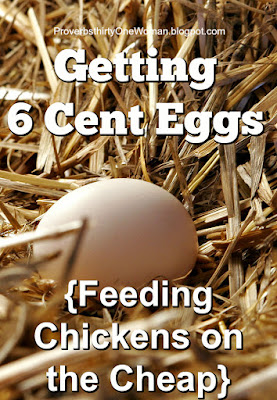But after a little figuring, I discovered our farm fresh eggs (which taste so much better than store bought and have more nutrition, too) actually cost less than store bought!
Granted, it's a little difficult to determine exactly how much each egg costs us because there is some fluctuation in how much our hens eat and how many eggs they lay. However, generally speaking, our eggs cost .06 cents each.
The last time I checked, the price of store bought eggs in our area (last spring), they were .15 cents each. Farm fresh eggs in our area are currently .25 cents each. That means we are saving $216 to $360 a year!
It's true I'm not factoring in start up costs. We spent $150 on a Craigslist coop and no more than $50, tops, for other chicken-related equipment. The chicks themselves were $1.50 each. (For more on the costs of owning chickens, check out "Setting Up the Hen House and Run" and "Buying Chickens and Caring for Chicks.") However, our only continuing expenses are bedding and feed. We keep those costs lower by:
1. Using straw as
 bedding
bedding2. Giving the chickens pellets
3. Hanging their feeder
4. Letting the hens free range in the yard
5. Giving the hens kitchen scraps
6. Giving the hens garden scraps
In our case, straw is an easy, cheap option. If you have cheap access to hay, wood chips, or shredded newspaper, those work well, too. Just don't use pine or cedar shavings or chips, since they can lead to health problems in chickens.
Pellets are more economical than crumble feed, since crumble - well - crumbles, leaving a lot of food on the floor to waste. A hanging feeder also helps prevent food from falling on the floor where it won't get eaten.
Because we have a garden we don't want decimated, we only allow our hens out when we are outside. But we've also noticed that the more we let our hens free range, the fewer eggs we get. (They are using energy to scratch around that would normally be put toward egg laying, no doubt. Plus, laying feed is specially formulated to give hens exactly the nutrition they need to lay very well; the less of it they eat, they less efficient their laying becomes.) So it's a toss up as to whether free ranging is an economical idea. (But at least occasional free ranging keeps the hens happier - and makes the eggs more nutritious, too.)
Giving the hens kitchen scraps, however, is definitely a wining practice. I give them anything I don't compost, including dairy, meat, and bread scraps. Since I have two small, picky-eater children, this amounts to quite a bit of food. I also let the hens have some food I'd normal compost - fruit and vegetable scraps. (I'm careful, however, not to give them much in the way of fruit peelings or veggies from the onion or garlic family, since these can make their eggs taste weird.) I still have plenty left over for actual composting.
I also find that garden scraps are a great addition to our hen's diets. Whenever I weed, for example, I just toss the weeds into their run and they gobble them up h
 appily. This winter, I also kept some vegetables in the garden when I normally would have torn them out. For example, I have Brussels sprouts stalks still growing. They don't produce anything very edible to humans right now, but the chickens love them. So I periodically cut one down and throw it in their run.
appily. This winter, I also kept some vegetables in the garden when I normally would have torn them out. For example, I have Brussels sprouts stalks still growing. They don't produce anything very edible to humans right now, but the chickens love them. So I periodically cut one down and throw it in their run.There is one last, important consideration if you want the most affordable, fresh eggs: the breed of chicken you choose. Many people I know are choosing their hens based on looks or egg color. But not all breeds of chickens produce eggs at the same rate. So before you buy, it's wise to read up on which breeds produce the most eggs; Backyard Chickens has a handy guide for quickly discovering which chickens are most likely to produce well. Personally, my favorites are Plymouths and Australorps.











Thanks for this read! I'm in the process of getting my own chickens set up
ReplyDeleteArvanah, I hope you enjoy them as much as we do!
ReplyDelete